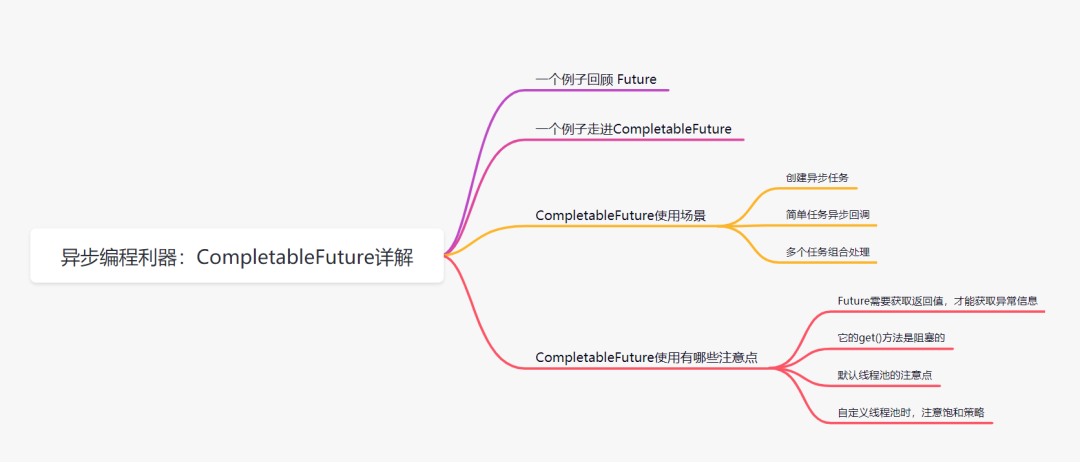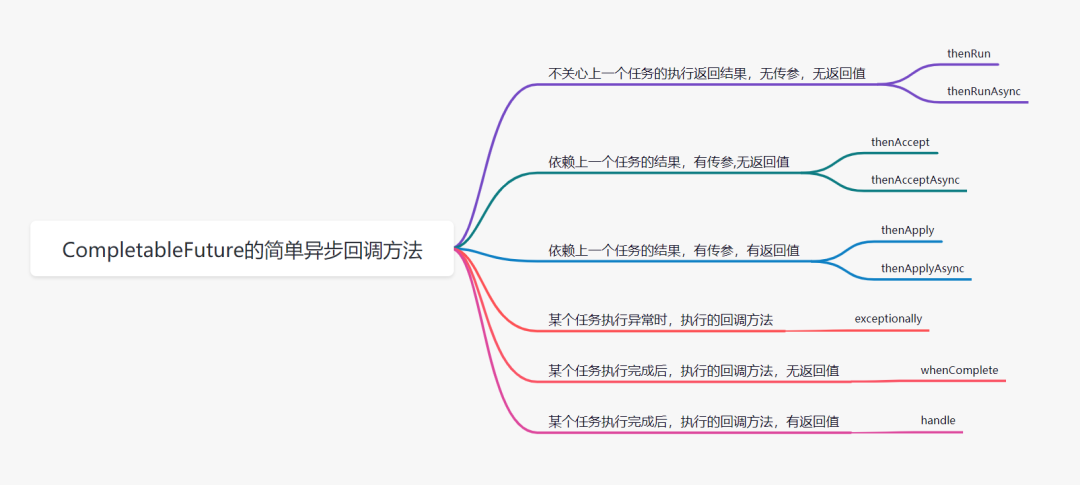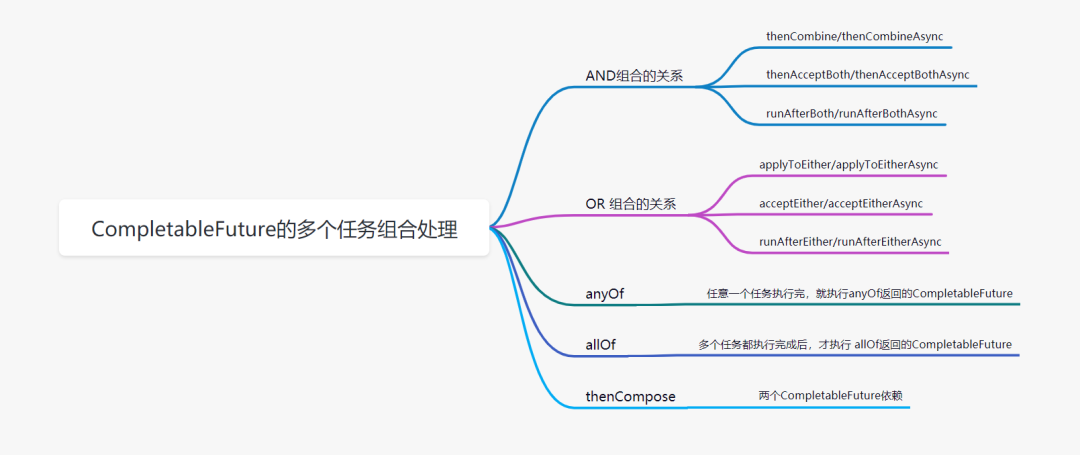異步編程利器:CompletableFuture詳解
前言
最近剛好使用CompeletableFuture優化了項目中的代碼,所以跟大家一起學習CompletableFuture。
一個例子回顧 Future
因為CompletableFuture實現了Future接口,我們先來回顧Future吧。
Future是Java5新加的一個接口,它提供了一種異步并行計算的功能。如果主線程需要執行一個很耗時的計算任務,我們就可以通過future把這個任務放到異步線程中執行。主線程繼續處理其他任務,處理完成后,再通過Future獲取計算結果。
來看個簡單例子吧,假設我們有兩個任務服務,一個查詢用戶基本信息,一個是查詢用戶勛章信息。如下,
- public class UserInfoService {
- public UserInfo getUserInfo(Long userId) throws InterruptedException {
- Thread.sleep(300);//模擬調用耗時
- return new UserInfo("666", "撿田螺的小男孩", 27); //一般是查數據庫,或者遠程調用返回的
- }
- }
- public class MedalService {
- public MedalInfo getMedalInfo(long userId) throws InterruptedException {
- Thread.sleep(500); //模擬調用耗時
- return new MedalInfo("666", "守護勛章");
- }
- }
接下來,我們來演示下,在主線程中是如何使用Future來進行異步調用的。
- public class FutureTest {
- public static void main(String[] args) throws ExecutionException, InterruptedException {
- ExecutorService executorService = Executors.newFixedThreadPool(10);
- UserInfoService userInfoService = new UserInfoService();
- MedalService medalService = new MedalService();
- long userId =666L;
- long startTime = System.currentTimeMillis();
- //調用用戶服務獲取用戶基本信息
- FutureTask<UserInfo> userInfoFutureTask = new FutureTask<>(new Callable<UserInfo>() {
- @Override
- public UserInfo call() throws Exception {
- return userInfoService.getUserInfo(userId);
- }
- });
- executorService.submit(userInfoFutureTask);
- Thread.sleep(300); //模擬主線程其它操作耗時
- FutureTask<MedalInfo> medalInfoFutureTask = new FutureTask<>(new Callable<MedalInfo>() {
- @Override
- public MedalInfo call() throws Exception {
- return medalService.getMedalInfo(userId);
- }
- });
- executorService.submit(medalInfoFutureTask);
- UserInfo userInfo = userInfoFutureTask.get();//獲取個人信息結果
- MedalInfo medalInfo = medalInfoFutureTask.get();//獲取勛章信息結果
- System.out.println("總共用時" + (System.currentTimeMillis() - startTime) + "ms");
- }
- }
運行結果:
- 總共用時806ms
如果我們不使用Future進行并行異步調用,而是在主線程串行進行的話,耗時大約為300+500+300 = 1100 ms。可以發現,future+線程池異步配合,提高了程序的執行效率。
但是Future對于結果的獲取,不是很友好,只能通過阻塞或者輪詢的方式得到任務的結果。
- Future.get() 就是阻塞調用,在線程獲取結果之前get方法會一直阻塞。
- Future提供了一個isDone方法,可以在程序中輪詢這個方法查詢執行結果。
阻塞的方式和異步編程的設計理念相違背,而輪詢的方式會耗費無謂的CPU資源。因此,JDK8設計出CompletableFuture。CompletableFuture提供了一種觀察者模式類似的機制,可以讓任務執行完成后通知監聽的一方。
一個例子走進CompletableFuture
我們還是基于以上Future的例子,改用CompletableFuture 來實現
- public class FutureTest {
- public static void main(String[] args) throws InterruptedException, ExecutionException, TimeoutException {
- UserInfoService userInfoService = new UserInfoService();
- MedalService medalService = new MedalService();
- long userId =666L;
- long startTime = System.currentTimeMillis();
- //調用用戶服務獲取用戶基本信息
- CompletableFuture<UserInfo> completableUserInfoFuture = CompletableFuture.supplyAsync(() -> userInfoService.getUserInfo(userId));
- Thread.sleep(300); //模擬主線程其它操作耗時
- CompletableFuture<MedalInfo> completableMedalInfoFuture = CompletableFuture.supplyAsync(() -> medalService.getMedalInfo(userId));
- UserInfo userInfo = completableUserInfoFuture.get(2,TimeUnit.SECONDS);//獲取個人信息結果
- MedalInfo medalInfo = completableMedalInfoFuture.get();//獲取勛章信息結果
- System.out.println("總共用時" + (System.currentTimeMillis() - startTime) + "ms");
- }
- }
可以發現,使用CompletableFuture,代碼簡潔了很多。CompletableFuture的supplyAsync方法,提供了異步執行的功能,線程池也不用單獨創建了。實際上,它CompletableFuture使用了默認線程池是ForkJoinPool.commonPool。
CompletableFuture提供了幾十種方法,輔助我們的異步任務場景。這些方法包括創建異步任務、任務異步回調、多個任務組合處理等方面。我們一起來學習吧
CompletableFuture使用場景
創建異步任務
CompletableFuture創建異步任務,一般有supplyAsync和runAsync兩個方法
創建異步任務
- supplyAsync執行CompletableFuture任務,支持返回值
- runAsync執行CompletableFuture任務,沒有返回值。
supplyAsync方法
//使用默認內置線程池ForkJoinPool.commonPool(),根據supplier構建執行任務
- //使用默認內置線程池ForkJoinPool.commonPool(),根據supplier構建執行任務
- public static <U> CompletableFuture<U> supplyAsync(Supplier<U> supplier)
- //自定義線程,根據supplier構建執行任務
- public static <U> CompletableFuture<U> supplyAsync(Supplier<U> supplier, Executor executor)
runAsync方法
- //使用默認內置線程池ForkJoinPool.commonPool(),根據runnable構建執行任務
- public static CompletableFuture<Void> runAsync(Runnable runnable)
- //自定義線程,根據runnable構建執行任務
- public static CompletableFuture<Void> runAsync(Runnable runnable, Executor executor)
實例代碼如下:
- public class FutureTest {
- public static void main(String[] args) {
- //可以自定義線程池
- ExecutorService executor = Executors.newCachedThreadPool();
- //runAsync的使用
- CompletableFuture<Void> runFuture = CompletableFuture.runAsync(() -> System.out.println("run,關注公眾號:撿田螺的小男孩"), executor);
- //supplyAsync的使用
- CompletableFuture<String> supplyFuture = CompletableFuture.supplyAsync(() -> {
- System.out.print("supply,關注公眾號:撿田螺的小男孩");
- return "撿田螺的小男孩"; }, executor);
- //runAsync的future沒有返回值,輸出null
- System.out.println(runFuture.join());
- //supplyAsync的future,有返回值
- System.out.println(supplyFuture.join());
- executor.shutdown(); // 線程池需要關閉
- }
- }
- //輸出
- run,關注公眾號:撿田螺的小男孩
- null
- supply,關注公眾號:撿田螺的小男孩撿田螺的小男孩
任務異步回調
1. thenRun/thenRunAsync
- public CompletableFuture<Void> thenRun(Runnable action);
- public CompletableFuture<Void> thenRunAsync(Runnable action);
CompletableFuture的thenRun方法,通俗點講就是,做完第一個任務后,再做第二個任務。某個任務執行完成后,執行回調方法;但是前后兩個任務沒有參數傳遞,第二個任務也沒有返回值
- public class FutureThenRunTest {
- public static void main(String[] args) throws ExecutionException, InterruptedException {
- CompletableFuture<String> orgFuture = CompletableFuture.supplyAsync(
- ()->{
- System.out.println("先執行第一個CompletableFuture方法任務");
- return "撿田螺的小男孩";
- }
- );
- CompletableFuture thenRunFuture = orgFuture.thenRun(() -> {
- System.out.println("接著執行第二個任務");
- });
- System.out.println(thenRunFuture.get());
- }
- }
- //輸出
- 先執行第一個CompletableFuture方法任務
- 接著執行第二個任務
- null
thenRun 和thenRunAsync有什么區別呢?可以看下源碼哈:
- private static final Executor asyncPool = useCommonPool ?
- ForkJoinPool.commonPool() : new ThreadPerTaskExecutor();
- public CompletableFuture<Void> thenRun(Runnable action) {
- return uniRunStage(null, action);
- }
- public CompletableFuture<Void> thenRunAsync(Runnable action) {
- return uniRunStage(asyncPool, action);
- }
如果你執行第一個任務的時候,傳入了一個自定義線程池:
- 調用thenRun方法執行第二個任務時,則第二個任務和第一個任務是共用同一個線程池。
- 調用thenRunAsync執行第二個任務時,則第一個任務使用的是你自己傳入的線程池,第二個任務使用的是ForkJoin線程池
TIPS: 后面介紹的thenAccept和thenAcceptAsync,thenApply和thenApplyAsync等,它們之間的區別也是這個哈。
2.thenAccept/thenAcceptAsync
CompletableFuture的thenAccept方法表示,第一個任務執行完成后,執行第二個回調方法任務,會將該任務的執行結果,作為入參,傳遞到回調方法中,但是回調方法是沒有返回值的。
- public class FutureThenAcceptTest {
- public static void main(String[] args) throws ExecutionException, InterruptedException {
- CompletableFuture<String> orgFuture = CompletableFuture.supplyAsync(
- ()->{
- System.out.println("原始CompletableFuture方法任務");
- return "撿田螺的小男孩";
- }
- );
- CompletableFuture thenAcceptFuture = orgFuture.thenAccept((a) -> {
- if ("撿田螺的小男孩".equals(a)) {
- System.out.println("關注了");
- }
- System.out.println("先考慮考慮");
- });
- System.out.println(thenAcceptFuture.get());
- }
- }
3. thenApply/thenApplyAsync
CompletableFuture的thenApply方法表示,第一個任務執行完成后,執行第二個回調方法任務,會將該任務的執行結果,作為入參,傳遞到回調方法中,并且回調方法是有返回值的。
- public class FutureThenApplyTest {
- public static void main(String[] args) throws ExecutionException, InterruptedException {
- CompletableFuture<String> orgFuture = CompletableFuture.supplyAsync(
- ()->{
- System.out.println("原始CompletableFuture方法任務");
- return "撿田螺的小男孩";
- }
- );
- CompletableFuture<String> thenApplyFuture = orgFuture.thenApply((a) -> {
- if ("撿田螺的小男孩".equals(a)) {
- return "關注了";
- }
- return "先考慮考慮";
- });
- System.out.println(thenApplyFuture.get());
- }
- }
- //輸出
- 原始CompletableFuture方法任務
- 關注了
4. exceptionally
CompletableFuture的exceptionally方法表示,某個任務執行異常時,執行的回調方法;并且有拋出異常作為參數,傳遞到回調方法。
- public class FutureExceptionTest {
- public static void main(String[] args) throws ExecutionException, InterruptedException {
- CompletableFuture<String> orgFuture = CompletableFuture.supplyAsync(
- ()->{
- System.out.println("當前線程名稱:" + Thread.currentThread().getName());
- throw new RuntimeException();
- }
- );
- CompletableFuture<String> exceptionFuture = orgFuture.exceptionally((e) -> {
- e.printStackTrace();
- return "你的程序異常啦";
- });
- System.out.println(exceptionFuture.get());
- }
- }
- //輸出
- 當前線程名稱:ForkJoinPool.commonPool-worker-1
- java.util.concurrent.CompletionException: java.lang.RuntimeException
- at java.util.concurrent.CompletableFuture.encodeThrowable(CompletableFuture.java:273)
- at java.util.concurrent.CompletableFuture.completeThrowable(CompletableFuture.java:280)
- at java.util.concurrent.CompletableFuture$AsyncSupply.run(CompletableFuture.java:1592)
- at java.util.concurrent.CompletableFuture$AsyncSupply.exec(CompletableFuture.java:1582)
- at java.util.concurrent.ForkJoinTask.doExec(ForkJoinTask.java:289)
- at java.util.concurrent.ForkJoinPool$WorkQueue.runTask(ForkJoinPool.java:1056)
- at java.util.concurrent.ForkJoinPool.runWorker(ForkJoinPool.java:1692)
- at java.util.concurrent.ForkJoinWorkerThread.run(ForkJoinWorkerThread.java:157)
- Caused by: java.lang.RuntimeException
- at cn.eovie.future.FutureWhenTest.lambda$main$0(FutureWhenTest.java:13)
- at java.util.concurrent.CompletableFuture$AsyncSupply.run(CompletableFuture.java:1590)
- ... 5 more
- 你的程序異常啦
5. whenComplete方法
CompletableFuture的whenComplete方法表示,某個任務執行完成后,執行的回調方法,無返回值;并且whenComplete方法返回的CompletableFuture的result是上個任務的結果。
- public class FutureWhenTest {
- public static void main(String[] args) throws ExecutionException, InterruptedException {
- CompletableFuture<String> orgFuture = CompletableFuture.supplyAsync(
- ()->{
- System.out.println("當前線程名稱:" + Thread.currentThread().getName());
- try {
- Thread.sleep(2000L);
- } catch (InterruptedException e) {
- e.printStackTrace();
- }
- return "撿田螺的小男孩";
- }
- );
- CompletableFuture<String> rstFuture = orgFuture.whenComplete((a, throwable) -> {
- System.out.println("當前線程名稱:" + Thread.currentThread().getName());
- System.out.println("上個任務執行完啦,還把" + a + "傳過來");
- if ("撿田螺的小男孩".equals(a)) {
- System.out.println("666");
- }
- System.out.println("233333");
- });
- System.out.println(rstFuture.get());
- }
- }
- //輸出
- 當前線程名稱:ForkJoinPool.commonPool-worker-1
- 當前線程名稱:ForkJoinPool.commonPool-worker-1
- 上個任務執行完啦,還把撿田螺的小男孩傳過來
- 666
- 233333
- 撿田螺的小男孩
6. handle方法
CompletableFuture的handle方法表示,某個任務執行完成后,執行回調方法,并且是有返回值的;并且handle方法返回的CompletableFuture的result是回調方法執行的結果。
- public class FutureHandlerTest {
- public static void main(String[] args) throws ExecutionException, InterruptedException {
- CompletableFuture<String> orgFuture = CompletableFuture.supplyAsync(
- ()->{
- System.out.println("當前線程名稱:" + Thread.currentThread().getName());
- try {
- Thread.sleep(2000L);
- } catch (InterruptedException e) {
- e.printStackTrace();
- }
- return "撿田螺的小男孩";
- }
- );
- CompletableFuture<String> rstFuture = orgFuture.handle((a, throwable) -> {
- System.out.println("上個任務執行完啦,還把" + a + "傳過來");
- if ("撿田螺的小男孩".equals(a)) {
- System.out.println("666");
- return "關注了";
- }
- System.out.println("233333");
- return null;
- });
- System.out.println(rstFuture.get());
- }
- }
- //輸出
- 當前線程名稱:ForkJoinPool.commonPool-worker-1
- 上個任務執行完啦,還把撿田螺的小男孩傳過來
- 666
- 關注了
多個任務組合處理
AND組合關系
thenCombine / thenAcceptBoth / runAfterBoth都表示:將兩個CompletableFuture組合起來,只有這兩個都正常執行完了,才會執行某個任務。
區別在于:
- thenCombine:會將兩個任務的執行結果作為方法入參,傳遞到指定方法中,且有返回值
- thenAcceptBoth: 會將兩個任務的執行結果作為方法入參,傳遞到指定方法中,且無返回值
- runAfterBoth 不會把執行結果當做方法入參,且沒有返回值。
- public class ThenCombineTest {
- public static void main(String[] args) throws InterruptedException, ExecutionException, TimeoutException {
- CompletableFuture<String> first = CompletableFuture.completedFuture("第一個異步任務");
- ExecutorService executor = Executors.newFixedThreadPool(10);
- CompletableFuture<String> future = CompletableFuture
- //第二個異步任務
- .supplyAsync(() -> "第二個異步任務", executor)
- // (w, s) -> System.out.println(s) 是第三個任務
- .thenCombineAsync(first, (s, w) -> {
- System.out.println(w);
- System.out.println(s);
- return "兩個異步任務的組合";
- }, executor);
- System.out.println(future.join());
- executor.shutdown();
- }
- }
- //輸出
- 第一個異步任務
- 第二個異步任務
- 兩個異步任務的組合
OR 組合的關系
applyToEither / acceptEither / runAfterEither 都表示:將兩個CompletableFuture組合起來,只要其中一個執行完了,就會執行某個任務。
區別在于:
- applyToEither:會將已經執行完成的任務,作為方法入參,傳遞到指定方法中,且有返回值
- acceptEither: 會將已經執行完成的任務,作為方法入參,傳遞到指定方法中,且無返回值
- runAfterEither:不會把執行結果當做方法入參,且沒有返回值。
- public class AcceptEitherTest {
- public static void main(String[] args) {
- //第一個異步任務,休眠2秒,保證它執行晚點
- CompletableFuture<String> first = CompletableFuture.supplyAsync(()->{
- try{
- Thread.sleep(2000L);
- System.out.println("執行完第一個異步任務");}
- catch (Exception e){
- return "第一個任務異常";
- }
- return "第一個異步任務";
- });
- ExecutorService executor = Executors.newSingleThreadExecutor();
- CompletableFuture<Void> future = CompletableFuture
- //第二個異步任務
- .supplyAsync(() -> {
- System.out.println("執行完第二個任務");
- return "第二個任務";}
- , executor)
- //第三個任務
- .acceptEitherAsync(first, System.out::println, executor);
- executor.shutdown();
- }
- }
- //輸出
- 執行完第二個任務
- 第二個任務
AllOf
所有任務都執行完成后,才執行 allOf返回的CompletableFuture。如果任意一個任務異常,allOf的CompletableFuture,執行get方法,會拋出異常
- public class allOfFutureTest {
- public static void main(String[] args) throws ExecutionException, InterruptedException {
- CompletableFuture<Void> a = CompletableFuture.runAsync(()->{
- System.out.println("我執行完了");
- });
- CompletableFuture<Void> b = CompletableFuture.runAsync(() -> {
- System.out.println("我也執行完了");
- });
- CompletableFuture<Void> allOfFuture = CompletableFuture.allOf(a, b).whenComplete((m,k)->{
- System.out.println("finish");
- });
- }
- }
- //輸出
- 我執行完了
- 我也執行完了
- finish
AnyOf
任意一個任務執行完,就執行anyOf返回的CompletableFuture。如果執行的任務異常,anyOf的CompletableFuture,執行get方法,會拋出異常
- public class AnyOfFutureTest {
- public static void main(String[] args) throws ExecutionException, InterruptedException {
- CompletableFuture<Void> a = CompletableFuture.runAsync(()->{
- try {
- Thread.sleep(3000L);
- } catch (InterruptedException e) {
- e.printStackTrace();
- }
- System.out.println("我執行完了");
- });
- CompletableFuture<Void> b = CompletableFuture.runAsync(() -> {
- System.out.println("我也執行完了");
- });
- CompletableFuture<Object> anyOfFuture = CompletableFuture.anyOf(a, b).whenComplete((m,k)->{
- System.out.println("finish");
- // return "撿田螺的小男孩";
- });
- anyOfFuture.join();
- }
- }
- //輸出
- 我也執行完了
- finish
thenCompose
thenCompose方法會在某個任務執行完成后,將該任務的執行結果,作為方法入參,去執行指定的方法。該方法會返回一個新的CompletableFuture實例
- 如果該CompletableFuture實例的result不為null,則返回一個基于該result新的CompletableFuture實例;
- 如果該CompletableFuture實例為null,然后就執行這個新任務
- public class ThenComposeTest {
- public static void main(String[] args) throws ExecutionException, InterruptedException {
- CompletableFuture<String> f = CompletableFuture.completedFuture("第一個任務");
- //第二個異步任務
- ExecutorService executor = Executors.newSingleThreadExecutor();
- CompletableFuture<String> future = CompletableFuture
- .supplyAsync(() -> "第二個任務", executor)
- .thenComposeAsync(data -> {
- System.out.println(data); return f; //使用第一個任務作為返回
- }, executor);
- System.out.println(future.join());
- executor.shutdown();
- }
- }
- //輸出
- 第二個任務
- 第一個任務
CompletableFuture使用有哪些注意點
CompletableFuture 使我們的異步編程更加便利的、代碼更加優雅的同時,我們也要關注下它,使用的一些注意點。
1. Future需要獲取返回值,才能獲取異常信息
- ExecutorService executorService = new ThreadPoolExecutor(5, 10, 5L,
- TimeUnit.SECONDS, new ArrayBlockingQueue<>(10));
- CompletableFuture<Void> future = CompletableFuture.supplyAsync(() -> {
- int a = 0;
- int b = 666;
- int c = b / a;
- return true;
- },executorService).thenAccept(System.out::println);
- //如果不加 get()方法這一行,看不到異常信息
- //future.get();
Future需要獲取返回值,才能獲取到異常信息。如果不加 get()/join()方法,看不到異常信息。小伙伴們使用的時候,注意一下哈,考慮是否加try...catch...或者使用exceptionally方法。
2. CompletableFuture的get()方法是阻塞的。
CompletableFuture的get()方法是阻塞的,如果使用它來獲取異步調用的返回值,需要添加超時時間~
- //反例
- CompletableFuture.get();
- //正例
- CompletableFuture.get(5, TimeUnit.SECONDS);
3. 默認線程池的注意點
CompletableFuture代碼中又使用了默認的線程池,處理的線程個數是電腦CPU核數-1。在大量請求過來的時候,處理邏輯復雜的話,響應會很慢。一般建議使用自定義線程池,優化線程池配置參數。
4. 自定義線程池時,注意飽和策略
CompletableFuture的get()方法是阻塞的,我們一般建議使用future.get(3, TimeUnit.SECONDS)。并且一般建議使用自定義線程池。
但是如果線程池拒絕策略是DiscardPolicy或者DiscardOldestPolicy,當線程池飽和時,會直接丟棄任務,不會拋棄異常。因此建議,CompletableFuture線程池策略最好使用AbortPolicy,然后耗時的異步線程,做好線程池隔離哈。
參考資料
[1]Java8 CompletableFuture 用法全解: https://blog.csdn.net/qq_31865983/article/details/106137777
[2]基礎篇:異步編程不會?我教你啊!: https://juejin.cn/post/6902655550031413262#heading-5
[3]CompletableFuture get方法一直阻塞或拋出TimeoutException: https://blog.csdn.net/xiaolyuh123/article/details/85023269
[4]編程老司機帶你玩轉 CompletableFuture 異步編程: https://zhuanlan.zhihu.com/p/111841508
[5]解決CompletableFuture異常阻塞: https://blog.csdn.net/weixin_42742643/article/details/111638260
本文轉載自微信公眾號「撿田螺的小男孩」,可以通過以下二維碼關注。轉載本文請聯系撿田螺的小男孩公眾號。


















































